
The following post was written by Gap Year Fellow Jennings Dixon.
Almost everyday, just past lunchtime, I receive visitors. Looking over the wall in front of my apartment and school, I know that once I have eaten, others will expect to eat as well. Almost like clockwork, three to four guests jump down from the coconut trees and land onto the bright orange house with lime green shutters across the street. Like experienced acrobats, they swing from the power lines with so much speed and nimbleness, it is not unlike flying. Within a matter of seconds, my visitors have arrived. I can only begin to guess what they will do that day.
My visitors, of course, are monkeys. Having lived my entire life in North Carolina, I had never seen a monkey before, unless it was behind glass at the zoo. But to see one so up close and wild it is quite exhilarating. I was surprised at first to notice how unafraid and uninterested they are by us humans, but I guess that is just the nature of their long coexistence with people here in the small South Indian town of Chengalpattu.
At first I thought that the monkeys would be wary around me, a rather large and new person; but I quickly found out that they do not know a stranger or the meaning of boundaries. One day, I had just eaten lunch and decided to lie down, tired from playing a game similar to tag called “Kabbadi” with the 3rd and 4th standard kids. Out of the corner of my eye, I saw a long curled grey tail walk by and into my kitchen. At first, I thought it must be some stray cat that decided to wander in. I got up and went into the kitchen. There, I found two of the monkeys staring and smiling back at me. I had no idea what to do since nothing like this had ever happened before, so I just stood there in awe and confusion. Within a matter of seconds, they ran past me, laughing mockingly. It wasn’t until they were outside that I noticed that they had stolen a bag of pigeon peas, which is used to make the lentil stew “sambar,” a popular dish here in the state of Tamil Nadu.
 Although my apartment and the school are connected to each other in the same purple and yellow building, I have yet to see one of the monkeys come inside the hallway or one of the classrooms. Occasionally while teaching one of my spoken English or English rhymes classes, we’ll get a glimpse of a monkey climbing a coconut tree. I’ve noticed that they like to perch on the ledge outside the auditorium on the second floor during the school’s weekly yoga lesson. The monkeys are experts at turning what should be a peaceful time of relaxation and meditation into utter, frantic chaos.
Although my apartment and the school are connected to each other in the same purple and yellow building, I have yet to see one of the monkeys come inside the hallway or one of the classrooms. Occasionally while teaching one of my spoken English or English rhymes classes, we’ll get a glimpse of a monkey climbing a coconut tree. I’ve noticed that they like to perch on the ledge outside the auditorium on the second floor during the school’s weekly yoga lesson. The monkeys are experts at turning what should be a peaceful time of relaxation and meditation into utter, frantic chaos.
Sometimes it feels as though I see the monkeys at other times of the day besides after lunch. 1st and 2nd standards’ rowdiness can especially rival that of the monkeys’. With each class size averaging around 20, the children like to climb on their chairs and desks, laugh, scream, and throw things. I have learned that yelling at them is just as ineffective as yelling at the monkeys for stealing, as my English makes as much sense to them as their Tamil makes sense to me. After a month of being here, it has gotten better. My younger students don’t imitate the wildness of monkeys quite as often as they used to.
India has established itself to be a place roaring with excitement. From the hectic traffic, to the earthshaking Diwali crackers, to the entertaining monkeys, there is never a dull moment outside my door. I never would have thought that any of this would be my reality, yet here I am. Thank you, monkeys, for always bringing a little mischief and amusement to my days.
